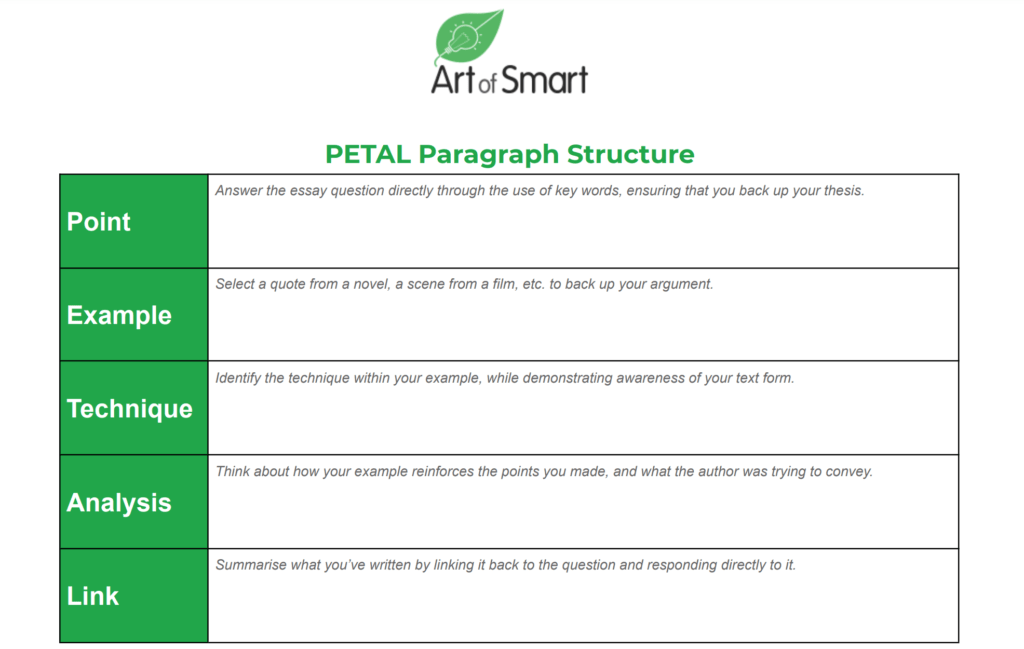
Writing an essay for English but are a little unsure about how to structure your body paragraphs? The PETAL paragraph structure will help you!
We’ll walk you through step by step how to write a PETAL paragraph, using ‘Unearth’ — a poem by Ali Cobby Eckermann.
Let’s dive right into how we’re going to make this PETAL shine in our body paragraphs!
What is a PETAL paragraph?
Step #1: Build Your Point
Step #2: Find Your Example
Step #3: Identify Your Technique
Step #4: Construct Your Analysis
Step #5: Wrap Up With Your Link
What is a PETAL paragraph?
PEEL, TEEL, PETAL… Sound familiar? When it comes to English, teachers often suggest following one of these structures in the body paragraphs of an English essay.
Why? Long explanation short, these mnemonics (patterns or words that can help us remember an idea or concept) are all variations of the same type of structure that students can follow.
Having such a mnemonic can help you ensure you hit the most important areas to cover in your body paragraphs, because at the end of the day, markers will be looking for this type of structure and adherence to it, or lack thereof, will most likely determine the mark students achieve in their essays.
The mnemonic we’re looking at in particular is PETAL — which stands for: Point, Example, Technique, Analysis, Link.

PETAL works as a structure for an individual example within a paragraph, as well as in a paragraph.
In saying that however, you should be writing more than one Example, Technique and Analysis in a single paragraph, so the actual English body paragraph structure may look a lot more like PETAPETAL or PETAETAETAL or even PETAETAPETAETAL!
Within these structures however, there would still be a mini Point and Link within each example you give.
As mentioned before, we’ll be using ‘Unearth’, a poem by Ali Cobby Eckermann, to show you how to write using the PETAL paragraph structure!
This particular text is on the Standard English syllabus for Module A: Language, Identity and Culture, but the pointers in this article can be used in any level of English, whether in the HSC or not!
Why is it important?
All of the components of PETAL must be included in your body paragraphs for any English essay, regardless of text, form, etc. if you are aiming for a high mark in your essay.
Without any one of these (Point, Example, Technique, Analysis or Link), students will not be able to achieve a high mark in their essays (e.g. Band 5 or 6 in the HSC).
Now let’s get into the actual structure!
Step #1: Build Your Point

What’s the point, I hear you ask? The Point, also known as your topic sentence, will establish what your argument in your body paragraph will be.
In the Point, you will respond directly to the essay question by using the key words and back up your thesis.
For example, in response to the question, “To what extent does Eckermann’s poetry depict a conflict between culture and identity?” a Point/topic sentence for a body paragraph could be:
In ‘Unearth’, a conflict between the notion of Australian culture and the collective identity of the Indigenous Australian people persists to a certain degree due to the negative impact of British colonisation.
Notice how in this sentence, “persists to a certain degree” responds to “to what extent” in the question and culture and identity are referred to directly.
It is essential that the Point is clear and to-the-point, as the marker will be reading this part first. If they do not understand your Point, you risk compromising your entire argument altogether and will not give them a good impression of the rest of the paragraph to come.
Although the PETAL structure consists of five main components, your body paragraph does not necessarily have to be limited to one sentence per component i.e. one sentence for your Point, another for your Example, etc.
Sometimes the Point is better split into two sentences, with the latter where you can introduce the text while in the former, you respond directly to the question using the key words!
Learn how to write awesome topic sentences!
Step #2: Find Your Example

Find an example from your text that backs up your argument. This could be a quote from a novel, a scene from a film, etc., but as a rule, the examples you select from your text must have a technique that you can discuss (more in Step 3!).
Finding good examples that are not used by every other student who is also studying the same text as you is really important, because it helps distinguish your argument from everyone else. Also, it demonstrates that you’ve had a close engagement with your text!
As a rule, avoid using overly long quotes such as anything longer than one sentence. If there is something that you just have to include that is a bit long, remember you can always use ellipsis so you don’t have to remember as much going into the exam and focus only on the essentials in the quote.
An appropriate example from the previously mentioned ‘Unearth’ is “excavation holes are dug in our minds.”
After you’ve selected your quote, consider where the quote itself is situated within the text as a whole — for example, the persona may have just had a revelation towards the end of the poem. So what would the context behind the quote tell us?
Considering where the quote is situated within the text can help us provide a deeper meaning beyond simply recounting what is written in the text, which is always important in your English body paragraphs.
Check out our analysis and a sample paragraph from Jane Eyre to get an idea of what we’re aiming for!
Step #3: Identify Your Technique

Figure out what Technique is being used in your Example. Preferably try to identify a Technique that demonstrates an awareness of form e.g. theatrical techniques for a Shakespearean play, because although yes, there are some nice metaphors in Shakespeare, he chose to write plays and not novels.
With films, try to use more than one film technique, such as a close-up shot combined with the dark lighting to, again, demonstrate greater awareness of form.
Now in ‘Unearth’, the technique used in “excavation holes are dug in our minds” is a metaphor.
If you’re really struggling to find a Technique for an Example, consider choosing a different Example, as you don’t want to be using a cookie cutter for something that doesn’t fit.
Learn about literary techniques and visual techniques!
Step #4: Construct Your Analysis

This is the toughest step of PETAL, but so crucial. Here, you need to analyse the aforementioned Example and Technique while referring to the question.
If you get confused as to what you can say about the Example and Technique, think back to your Point.
- How does the Example reinforce the Point you made?
- What is the author/poet/director/playwright trying to get at with the Example and Technique?
Make sure the Technique links to the Point, not just to the Example itself. At the end of the day, in our English essays, we are trying to analyse, not just point out examples and techniques to the marker.
An example of Analysis would be: The metaphor, “excavation holes are dug in our minds”, refers to the destruction of the land by the British settlers, but also the collective unity of the Indigenous Australian people despite the conflict in cultural appreciation of the environment.
Notice how the keywords (“conflict”, “culture”) from the question are being used here again, which shows there is an engagement with the question.
Again, avoid recounting at all costs! One way to do this could be to have the Example and the Technique in the one sentence, combined with your Analysis. Remember in your essay, you’re not telling the story of what happened in your text — you’re analysing the significance of what happened in the text.
Step #5: Wrap Up with Your Link

Now sum up what you have just written! But it won’t just be a reiteration of your Point. Link it back up to the question and respond to it directly.
Again, following our example: It becomes clear that whilst the culture and language of Australia has changed significantly, the collective Indigenous Australian identity will persevere; a conflict between culture and identity therefore exists in ‘Unearth’ to a certain degree.
It’s that easy!
And there you go. By following this PETAL paragraph structure, you’ll be well on your way to achieving your #EnglishGoals.
If you’d prefer to use a different paragraph structure, then you should check out how the STEEL paragraph structure, TEEL paragraph structure or the PEEL paragraph structure works!
Looking for some extra help with your PETAL paragraph?
We have an incredible team of English tutors and mentors!
We can help you master your English text and ace your upcoming English assessments with personalised lessons conducted one-on-one in your home, online or at one of our state of the art campuses in Hornsby or the Hills!
We’ve supported over 8,000 students over the last 11 years, and on average our students score mark improvements of over 20%!
To find out more and get started with an inspirational HSC English tutor and mentor, get in touch today or give us a ring on 1300 267 888!
Marina Liu is currently completing her Honours in French and Francophone Studies at the University of Sydney, having finished her Bachelor of Arts (Languages). She has over 3 years of experience supporting senior English students at Art of Smart Education. In her spare time, she loves giving herself a manicure and listening to music from My Chemical Romance to Simon and Garfunkel.



